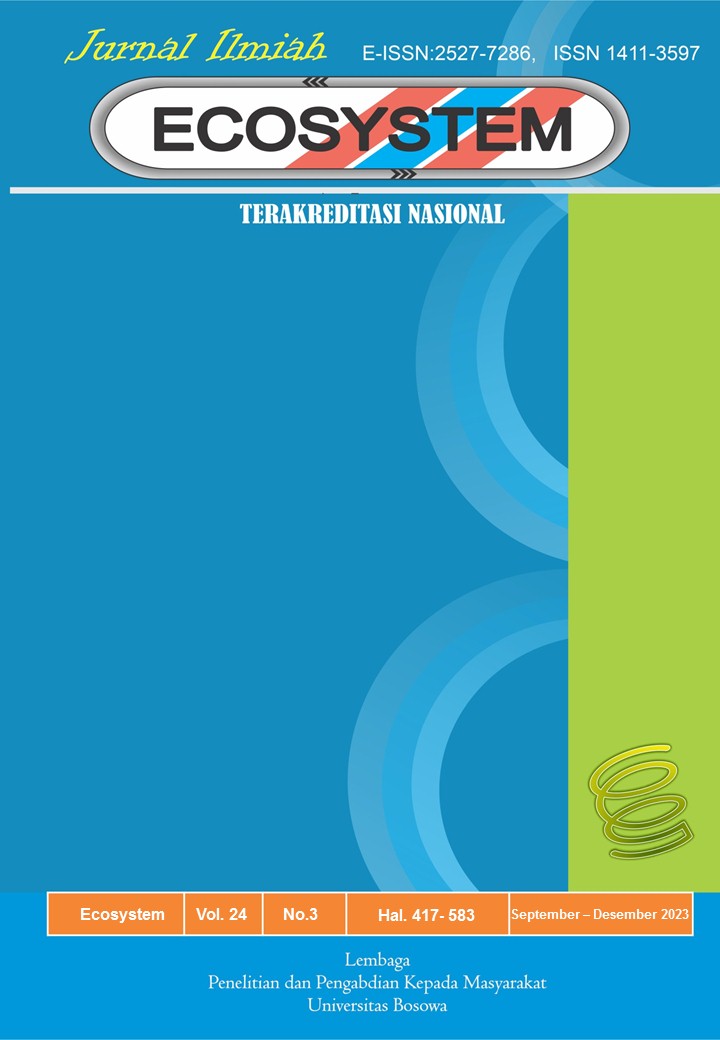Kajian Sosial Dan Implikasi Sosiologi Pembagian Jalan Lingkar Berbas Pantai Tanjung Laut Indah Kota Bontang Kalimantan Timur
DOI:
https://doi.org/10.35965/eco.v24i3.5535Keywords:
Jalan Lingkar, Persepsi Masyarakat, Dampak LingkunganAbstract
Tujuan penelitian ini adalah untuk menganalisis persepsi masyarakat terhadap rencana pembangunan Jalan Lingkar Berbas Pantai – Tanjung Laut Indah di Kota Bontang serta mengevaluasi dampak sosial dan lingkungan yang mungkin timbul. Metode penelitian yang digunakan adalah mix method, menggabungkan pendekatan kualitatif melalui wawancara mendalam dan kuantitatif melalui survei yang melibatkan 45 responden. Hasil penelitian menunjukkan bahwa mayoritas responden mengetahui rencana pembangunan, namun pemahaman mengenai tujuan dan kebijakan pemerintah masih terbatas. Di samping itu, pembangunan jalan diharapkan dapat meningkatkan aksesibilitas, mengurangi keterisolasian wilayah pesisir, serta menciptakan peluang ekonomi baru. Namun, potensi dampak negatif terhadap lingkungan, terutama pada kawasan mangrove, perlu diatasi melalui mitigasi yang tepat. Pembahasan menunjukkan pentingnya keterlibatan masyarakat dalam perencanaan proyek untuk mencapai keberhasilan yang inklusif dan berkelanjutan.
The purpose of this study was to analyze public perceptions of the planned development of the Berbas Pantai – Tanjung Laut Indah Ring Road in Bontang City and to evaluate the possible social and environmental impacts. The research method used was a mix method, combining a qualitative approach through in-depth interviews and a quantitative approach through a survey involving 45 respondents. The results showed that the majority of respondents were aware of the development plan, but their understanding of government goals and policies was still limited. In addition, road construction is expected to improve accessibility, reduce the isolation of coastal areas, and create new economic opportunities. However, the potential negative impacts on the environment, especially in mangrove areas, need to be addressed through appropriate mitigation. The discussion shows the importance of community involvement in project planning to achieve inclusive and sustainable success.
Downloads
References
Abukari, Haruna, and Raphael Benedict Mwalyosi. 2020. “Local Communities’ Perceptions about the Impact of Protected Areas on Livelihoods and Community Development.” Global Ecology and Conservation 22: https://doi.org/10.1016/j.gecco.2020.e00909.
Bridge, Gavin, Begüm Özkaynak, and Ethemcan Turhan. 2018. “Energy Infrastructure and the Fate of the Nation: Introduction to Special Issue.” Energy Research and Social Science 41 (April): 1–11. https://doi.org/10.1016/j.erss.2018.04.029.
Delphine, Patrick Witte, and Tejo Spit. 2022. “Bridging the Perception Gap? When Top-down Built Megaprojects Meet Bottom-up Perceptions: A Case Study of Suramadu Bridge, Indonesia.” Asian Geographer 39 (1): 21–43. https://doi.org/10.1080/10225706.2020.1750441.
Gnanapala, Athula C. 2016. “Community Perception on Tourism Development and Its Impacts: A Study on Passikudha, Sri Lanka.” Tourism, Leisure and Global Change 3 (2016): 164.
Haleem, Abid, Sunil Luthra, Bisma Mannan, Sonal Khurana, Sanjay Kumar, and Sirajuddin Ahmad. 2016. “Critical Factors for the Successful Usage of Fly Ash in Roads & Bridges and Embankments: Analyzing Indian Perspective.” Resources Policy 49:334–48. https://doi.org/10.1016/j.resourpol.2016.07.002.
Ongkowijoyo, Citra S., Argaw Gurmu, and Andi Andi. 2021. “Investigating Risk of Bridge Construction Project: Exploring Suramadu Strait-Crossing Cable-Stayed Bridge in Indonesia.” International Journal of Disaster Resilience in the Built Environment 12 (1): 127–42. https://doi.org/10.1108/IJDRBE-03-2020-0018.
Putri, Intan Hapsari Surya, Imam Buchori, and Wiwandari Handayani. 2022. “Hydrometeorological Disaster Assessment: Study of Risk and Loss Assessment of Disaster Events in Central Java.” Sustainability and Climate Change 15 (6): 446–60. https://doi.org/10.1089/scc.2022.0098.
Tran, Kim Chi, Jorge Euan, and Maria Luisa Isla. 2002. “Public Perception of Development Issues: Impact of Water Pollution on a Small Coastal Community.” Ocean and Coastal Management 45 (6–7): 405–20. https://doi.org/10.1016/S0964-5691(02)00077-7.
Wu, Jingrong, and Xiang Jiang. 2024. “Flood Disaster Risk Assessment in Wuhan City Based on GIS Analysis and Indicator Ranking Using Random Forest.” Buildings 14 (5): 14051370. https://doi.org/10.3390/buildings14051370.
Wuryanta, A. 2022. “Study of Ecodrainage System for Hydrometeorological Disaster Mitigation.” IOP Conference Series: Earth and Environmental Science 1109 (1): 12029. https://doi.org/10.1088/1755-1315/1109/1/012029.
Hanifah, U. (2019). Transformasi sosial masyarakat Samin di Bojonegoro (Analisis perubahan sosial dalam pembagian kerja dan solidaritas sosial Emile Durkheim). Jurnal Sosiologi Agama, 13(1), 41-71.
Rasyid, M. R. (2015). Pendidikan Dalam Perspektif Teori Sosiologi. AULADUNA: Jurnal Pendidikan Dasar Islam, 2(2), 274-286.
Rasid, A. (2018). Implikasi Landasan-Landasan Pendidikan. AL-FIKRAH: Jurnal Studi Ilmu Pendidikan Dan Keislaman, 1(1), 1-15.
Arif, A. M. (2020). Perspektif Teori Sosial Emile Durkheim Dalam Sosiologi Pendidikan. Moderasi: Jurnal Studi Ilmu Pengetahuan Sosial, 1(2), 1-14.
Mujamil, A., Riwanda, A., & Moefad, A. M. (2023). Dakwah Partisipatoris Untuk Transformasi Sosial: Diskursus Manajemen Dakwah Dalam Perspektif Sosiologi-Pengetahuan. Mawaizh: Jurnal Dakwah Dan Pengembangan Sosial Kemanusiaan, 14(2), 155-182.
Downloads
Published
Issue
Section
License
Copyright (c) 2024 Iskandar Iskandar, Muhammad Sabiq

This work is licensed under a Creative Commons Attribution 4.0 International License.












